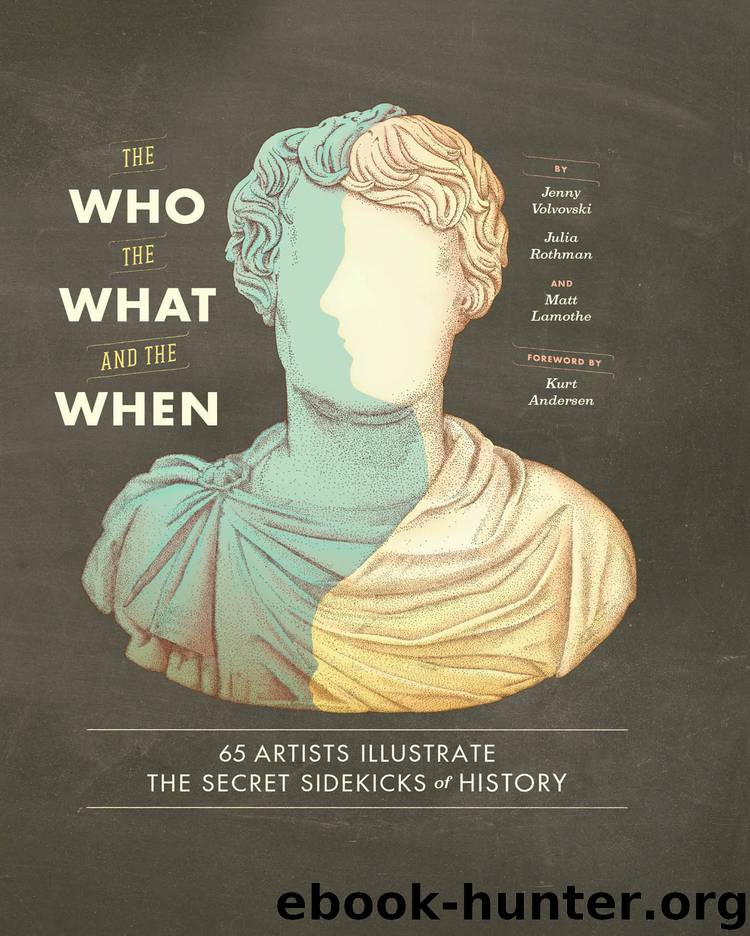The Who, the What, and the When by Jenny Volvovski

Author:Jenny Volvovski [Jenny Volvovski, Julia Rothman and Matt Lamothe]
Language: eng
Format: epub
Publisher: Chronicle Books LLC
Published: 2014-04-11T04:00:00+00:00
WRITTEN BY SVETLANA KITTO
www.svetlanakitto.com
ILLUSTRATED BY KATTY MAUREY
www.kattymaurey.tumblr.com
1758 MARIE ANNE LAVOISIER 1836
ANTOINE LAVOISIER’S WIFE
WHEN JACQUES-LOUIS DAVID WAS COMMISsioned to paint the portrait of the great eighteenth-century French chemist Antoine Lavoisier and his wife Marie Anne, he had evidently figured out who was really in charge of the relationship. Madame Lavoisier dominates the scene, gazing confidently at the viewer while Antoine, looking adoringly and a trifle nervously at his wife, seems to be writing under her instruction. A black-stockinged leg, pinned between her flowing skirts and the scarlet table drape, rightly suggests that this relationship doesn’t lack for passion.
But it began as a marriage of convenience. In 1771, Marie’s father, Jacques Paulze, a senior partner in the firm of tax collectors that the aristocratic Lavoisier joined, needed to marry her off to escape the insistence of a baroness that she be wed to the baroness’s middle-aged brother. Marie, aged just thirteen, insisted she’d have nothing to do with that old “fool and ogre,” and so she agreed to marry the dashing young scientist instead.
Antoine Lavoisier had already made a name for himself for his chemical studies and in 1768, aged twenty-five, had been elected to the French Academy of Sciences. In the 1770s he conducted his most brilliant work, deducing that substances burn not because they release an inflammable vapor called phlogiston (as just about all chemists then believed) but because they combine with a component of the air, which he called oxygen. Lavoisier’s oxygen theory of combustion revolutionized chemistry, making sense of a whole range of phenomena, from respiration to the formation of acids.
In the 1780s Lavoisier used his oxygen theory to construct a whole new framework for chemistry. He clarified what a chemical element is (a substance that can’t be reduced to anything simpler), compiled a list of no fewer than thirty-three of them, and developed methods for “analyzing” chemical compounds: splitting them into their elements and figuring out the relative proportions of each. Lavoisier’s 1789 book Elementary Treatise on Chemistry laid the basis for the future of chemistry.
But Marie didn’t stand back demurely while her brilliant husband worked away in the lab. She became his indispensable assistant. From the beginning, the young woman took a keen interest in his studies, and his friends were soon calling her his “philosophical wife.” She learned chemistry, kept notes of his results, made sketches of his lab and equipment, and drew the illustrations for his 1789 book—she was an excellent artist, studying under Jacques-Louis David himself. She organized and hosted the philosophical soirées at which Lavoisier discussed science with his peers.
Most usefully of all, she translated chemical works for Antoine from English, which he never mastered. Without Marie, he would have struggled to read and then demolish the Irish chemist Richard Kirwan’s “Essay on Phlogiston”—a task central to his formulation of the oxygen theory.
Lavoisier’s involvement with tax collectors, and his work for Louis XVI’s government, were his undoing. In the French Revolution’s Reign of Terror he was accused of misconduct, and in 1794 he was sent to the guillotine.
Download
This site does not store any files on its server. We only index and link to content provided by other sites. Please contact the content providers to delete copyright contents if any and email us, we'll remove relevant links or contents immediately.
The Art of Boudoir Photography: How to Create Stunning Photographs of Women by Christa Meola(18457)
Red Sparrow by Jason Matthews(5310)
Harry Potter 02 & The Chamber Of Secrets (Illustrated) by J.K. Rowling(3591)
In a Sunburned Country by Bill Bryson(3438)
Drawing Cutting Edge Anatomy by Christopher Hart(3397)
Figure Drawing for Artists by Steve Huston(3337)
Harry Potter and the Prisoner of Azkaban (Book 3) by J. K. Rowling(3238)
The Daily Stoic by Holiday Ryan & Hanselman Stephen(3183)
Japanese Design by Patricia J. Graham(3070)
The Roots of Romanticism (Second Edition) by Berlin Isaiah Hardy Henry Gray John(2844)
Make Comics Like the Pros by Greg Pak(2808)
Stacked Decks by The Rotenberg Collection(2761)
Draw-A-Saurus by James Silvani(2598)
Harry Potter and the Deathly Hallows (7) by J.K. Rowling(2598)
Tattoo Art by Doralba Picerno(2557)
On Photography by Susan Sontag(2529)
Churchill by Paul Johnson(2453)
The Daily Stoic by Ryan Holiday & Stephen Hanselman(2410)
Foreign Devils on the Silk Road: The Search for the Lost Treasures of Central Asia by Peter Hopkirk(2396)
